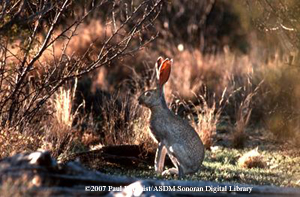Animal Fact Sheet: Black-tailed Jackrabbit

Identifying Features
The black-tailed jackrabbits (Lepus californicus) most identifying feature is its huge ears. The ears along with the tail are tipped with black fur. It has long slender front legs and large hind feet that can be 5 inches in length.
Adaptations
The large ears of this hare help it to lose heat and thereby cooling its body temperature. They have large eyes that are high on their head and placed toward the side. This along with the fact that their head is slightly flat allows them to see almost 360 degrees (a full circle) helping to spot predators.
Habitat
They like open flat places along with desert scrub and mesquite grasslands.
Range
They are found from Baja California and south-central Mexico to west-central and western United States.
Wild Status
Jackrabbits are not threatened or endangered.
Diet
These hares are herbivores, feeding on grasses, leaves, clover, alfalfa, twigs, seeds, beans, twigs and cacti.
Predators
Jackrabbits are an important food source for many animals. These can include coyotes, Red-tailed Hawks, Ferruginous Hawks, eagles, foxes, bobcats, and humans.
Home
Jackrabbits will often rest in the shade during the heat of the day in a shallow depression under grass or bushes. They do not live in burrows. They will often forage or rest in groups relying on the eyes and ears of each other for protection. Females will give birth in thick brush or in depressions lined with fur.
Life Span
In the wild on average jackrabbits live 2-5 years. They usually live longer when in a zoological setting.
Size
Adult black-tailed jackrabbits weigh from 3-7 pounds and are about two feet in length.
Extra Fun-facts
- The black-tailed jackrabbit is not really a rabbit, it is a hare. This is because its young are born with fur and with their eyes already open.
- Jackrabbits can run as fast as 40 mph in short bursts in order to escape predators.
- Baby jackrabbits are called leverets.
 ©Copyright 2008, Arizona-Sonora Desert Museum
©Copyright 2008, Arizona-Sonora Desert Museum